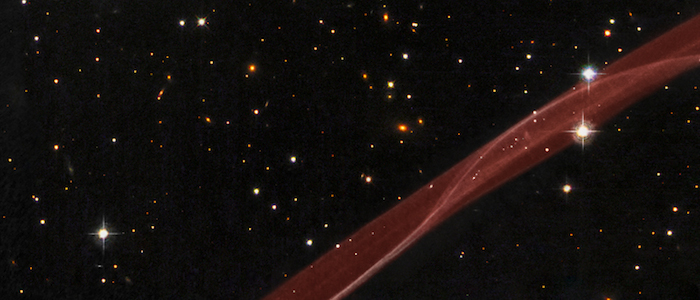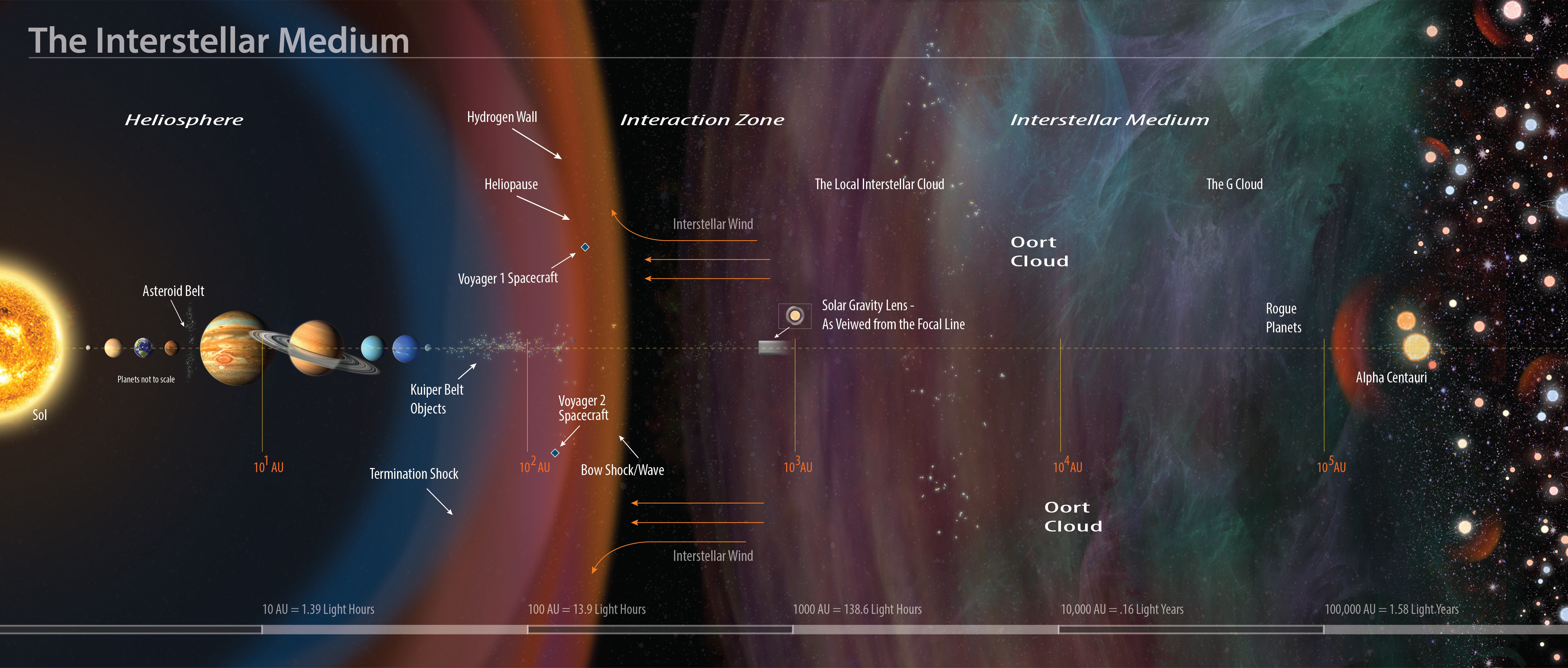
Contact Information
Astronomy Department96 Foss Hill Drive
Van Vleck Observatory 101
Wesleyan University
Middletown, CT 06459
(860) 685-3669 (office)
(860) 685-2131 (fax)
sredfield@wesleyan.edu
The Local Interstellar Medium in 3D
The space between the stars is filled with gas and dust. Spectacular displays of this interstellar medium (ISM) can be found in star-forming regions where new stars are being created from the ISM, as well as in planetary nebulae and supernova remnants where old stars are returing much of their mass back into space. I explore the region just around the Sun, within approximately 100 pc, which is home to the local interstellar medium (LISM). Here we find a suite of warm, modest density, partially ionized clouds (see figure below).
I use high-resolution spectra of nearby stars acquired from the Hubble Space Telescope, which show absorption lines caused by these LISM clouds. This tenuous material can only be detected by the strongest atomic transitions, which are predominately found in the ultraviolet. This explains the recent growth of this field and our need for a space-based telescope.
Recent Papers On This Topic:
1. Evaluating the
Morphology of the Local Interstellar Medium: Using New Data
to Distinguish Between Multiple Discrete Clouds and a
Continuous Medium Redfield, S., &
Linsky, J.L. 2015, ApJ, 812, 125
We use a new sample of HST observations to test between
a LISM morphology of a single LISM cloud that is
kinematically deformed or a multiple cloud model. We find
the multiple cloud model is preferred, even though it
utilizes more parameters.
2. The Structure of the
Local Interstellar Medium. VI. New Mg II, Fe II, and Mn II Observations toward Stars within 100 pc
Malamut, C., Redfield, S., Linsky, J.L., Wood, B.E.,
& Ayres, T.R. 2014, ApJ, 787, 75
Lead by Wesleyan BA/MA student Craig Malamut, we analyzed the
absorption lines of a
sample of >30 new sight lines through the LISM. We tested the
Redfield & Linsky (2008) kinematic model, refined an
astrospheric detection, and found absorption due to the odd
debris disk of 49 Ceti.
3. The Interstellar
Medium Surrounding the Sun Frisch,
P.C., Redfield, S., & Slavin, J.D. 2011, ARAA, 49,
237
A review of our current understanding of the Local
Interstellar Medium.
4. The Structure of the Local
Interstellar Medium IV: Dynamics, Morphology, Physical
Properties, and Implications of Cloud-Cloud
Interactions Redfield, S., & Linsky,
J.L. 2008, ApJ, 673, 283
A new kinematic model of the suite of 15 clouds within about 15 pc of
the Sun. An online LISM Kinematic
Calculator is available to predict the velocity of absorption along any given sight line.
5. What is the Total Deuterium
Abundance in the Local Galactic Disk? Linsky,
J.L., Draine, B.T., Moos, H.W., Jenkins, E.B., Wood, B.E., Oliveira,
C., Blair, W.P., Friedman, S.D., Gry, C., Knauth, D., Lacour, S.,
Lehner, N., Redfield, S., Shull, J.M., Sonneborn, G., & Williger,G.M.
2006, ApJ, 647, 1106
A detailed evaluation of deuterium abundances throughout the Galaxy.
In the LISM, the ratio of deuterium to hydrogen is constant, arguing
for a common origin or evolution.
6. The Three-dimensional
Structure of the Warm Local Interstellar Medium. II. The Colorado Model of the Local Interstellar Cloud Redfield, S., & Linsky, J.L. 2000, ApJ, 534, 825
My first paper on the LISM that I led, and the beginning of a long
series of papers with my
Ph.D. advisor, Jeff Linsky. We developed a model of the morphology of
the Local Interstellar Cloud, the cloud that directly surrounds the
solar system, and the material in which the Voyager spacecraft are
speeding into. An online LIC Model Column Density
Calculator is available to predict the amount of material
associated with the LIC along any given sight line. This work was
featured in Physics
Today and Sky & Telescope.
Astrospheres: When Stars Meet ISM
Stars have outward moving winds (sometimes clumps in these winds hit the Earth and cause dramatic aurorae), while the surrounding ISM acts to confine this wind. This interaction creates the heliosphere, in the case of the Sun, and astrospheres, more generally around any star. A schematic of this interaction is shown below.
It is possible to measure the astrospheric interface in the strongest transtion of the most abundant element, hydrogen, specifically the Lyman-α line. If we know the properties of the LISM, we can then deduce the properties of the stellar wind. Because stellar winds have such a profound influence on planetary atmospheres, I am intrigued by this connection between my research areas of the LISM and exoplanetary atmospheres.
Recent Papers On This Topic:
1. The Interstellar Medium in
the Kepler Search Volume Johnson,
M.C., Redfield, S., & Jensen, A.G. 2015, ApJ, 807,
162
Inspired by a trip to McDonald Observatory by myself and a
senior undergraduate, Marshall Johnson. We analyzed the ISM
properties in the Kepler volume and predicted the
astrospheric properties for several
planetary systems. This work was featured in New
Scientist.
2. Evidence for a Weak
Wind from the Young Sun Wood, B.E.,
Müller, H.-R., Redfield, S., & Edelman, E. 2014, ApJL,
781, L33
We detected the astrosphere of a youthful solar analog. The
ISM analysis was performed by BA/MA Eric Edelman.
3. A New Detection of LYα
Absorption from the Heliotail Wood,
B.E., Izmodenov, V.V., Alexashov, D.B., Redfield, S., &
Edelman, E. 2014, ApJ, 780, 108
We detected heliospheric absorption in the direction of the
cometary-like tail of the heliosphere as it speeds through the
LISM. The ISM analysis was perfored by BA/MA Eric Edelman.
4. Probing Our
Heliospheric History. I. High-resolution Observations of Na I
and Ca II along the Solar Historical
Trajectory Wyman, K., & Redfield, S.
2013, ApJ, 773, 96
We analyzed a large sample of ground-based ISM observations
along the direction of that the Sun has traveled over the last
40 million years. This interstellar "ice-core" allows us to
reconstruct the ISM environments that the Sun may have
traversed over this time, and thereby predict the heliospheric
response to these interstellar conditions. This was lead by
MA student, Katherine Wyman.
5. New Mass Loss Measurements
from Astrospheric Lyα Absorption Wood,
B.E., Müller, H.-R., Zank, G.P., Linsky, J.L., & Redfield, S. 2005, ApJL, 628, L143
We present several new astrospheric detections, bringing the total to
around a dozen. This kind of measurement can only be done with
high-resolution ultraviolet spectra observed from space.

